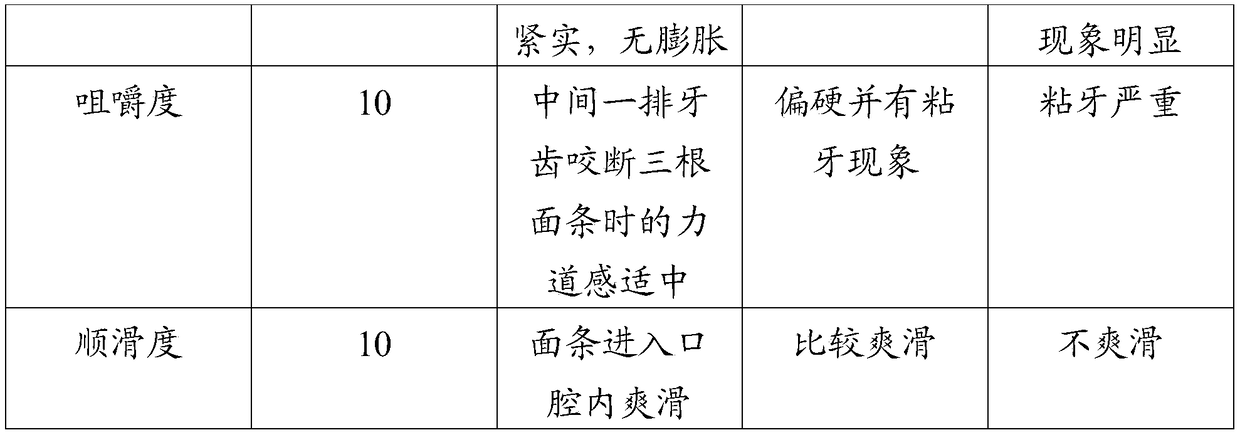Bran-free grain noodles and making method thereof
A gluten-free and noodle technology, applied in food science, food ingredients, applications, etc., can solve the problems of not being able to form good quality noodles, and achieve the effects of improving viscoelasticity, low breaking rate, and good flavor
- Summary
- Abstract
- Description
- Claims
- Application Information
AI Technical Summary
Benefits of technology
Problems solved by technology
Method used
Image
Examples
preparation example Construction
[0035] The present invention provides a kind of preparation method of the noodles described in above-mentioned scheme, comprises the steps:
[0036]1) activating after mixing yeast powder, plant lactobacillus powder and 3% to 5% water of the total weight, to obtain a fermented liquid;
[0037] 2) Heating the rest of the water to 100°C, mixing and stirring with 70% to 80% of the total weight of gluten-free grain flour to obtain the first kneaded dough, after the first kneaded dough is cooled to 28 to 32°C, add Gluten protein plant protein powder, salt, flour improver, TG enzyme and the fermented liquid of step 1) are mixed and stirred to obtain the second stirred dough;
[0038] 3) Fermenting the second kneaded dough in step 2) at 28-30°C for 1.5-2 hours, then fermenting at 38-40°C for 30-60 minutes, and then fermenting at 48-52°C for 20-30 minutes to obtain fermented dough;
[0039] 4) mixing and stirring the fermented dough in step 3) with the remaining gluten-free grain powder
Embodiment 1
[0050] Weigh 1.0Kg of corn flour, 0.1Kg of soybean flour, 10g of instant dry yeast powder, 50g of TG enzyme, 10g of plant lactobacillus powder, 30g of salt, 10g of flour improver and 600g of water.
[0051] 1) After heating water to 35°C, mix and activate yeast powder, plant lactobacillus powder and 25g water for 18 minutes to obtain fermentation broth;
[0052] 2) Heat the rest of the water to 100°C, mix it with 80% of the total weight of gluten-free grain flour and stir for 20 minutes at a speed of 50r / min to obtain the first kneaded dough, after the first kneaded dough is cooled to 28°C add Vegetable protein powder without gluten, salt, flour improver, TG enzyme and the fermented liquid of step 1) were stirred at a speed of 12r / min for 15min to obtain the second stirred dough;
[0053] 3) Fermenting the second stirred dough in step 2) at 30°C for 1.5 hours, then fermenting at 40°C for 30 minutes, and then fermenting at 52°C for 20 minutes to obtain fermented dough;
[005
Embodiment 2
[0057] Weigh 1.2Kg of sorghum flour, 50g of soybean protein powder, 20g of yeast powder, 10g of TG enzyme, 50g of plant lactobacillus powder, 10g of salt, 20g of flour improver and 500g of water.
[0058] 1) After heating water to 40°C, mix and activate yeast powder, plant lactobacillus powder and 25g water for 12 minutes to obtain fermentation broth;
[0059] 2) Heat the rest of the water to 100°C, mix it with 70% of the total weight of gluten-free grain flour and stir for 10 minutes at a speed of 70r / min to obtain the first kneaded dough, after the first kneaded dough is cooled to 32°C, add Stir the fermented liquid without gluten protein vegetable protein powder, salt, flour improver, TG enzyme and step 1) at a speed of 10 r / min for 20 min to obtain the second kneaded dough;
[0060] 3) Fermenting the second stirred dough in step 2) at 28°C for 2 hours, then fermenting at 38°C for 60 minutes, and then fermenting at 48°C for 30 minutes to obtain fermented dough;
[0061] 4
PUM
| Property | Measurement | Unit |
|---|---|---|
| Length | aaaaa | aaaaa |
Abstract
Description
Claims
Application Information
 Login to view more
Login to view more - R&D Engineer
- R&D Manager
- IP Professional
- Industry Leading Data Capabilities
- Powerful AI technology
- Patent DNA Extraction
Browse by: Latest US Patents, China's latest patents, Technical Efficacy Thesaurus, Application Domain, Technology Topic.
© 2024 PatSnap. All rights reserved.Legal|Privacy policy|Modern Slavery Act Transparency Statement|Sitemap


